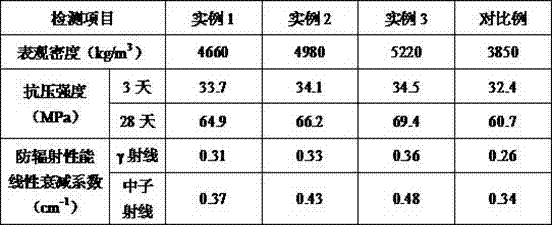Anti-radiation concrete and preparation method thereof
A technology for concrete and radiation protection, applied in the field of radiation protection concrete and its preparation, can solve the problems of poor concrete construction, influence of radiation resistance, poor segregation resistance, etc.
- Summary
- Abstract
- Description
- Claims
- Application Information
AI Technical Summary
Problems solved by technology
Method used
Image
Examples
example 1
[0024] Get 100g of graphite, 300g of barite, 200g of hematite and 80g of serpentine and add them to a pulverizer to pulverize for 40 minutes to obtain a mixed powder. Add the mixed powder and biogas slurry to the fermenter at a mass ratio of 1:5, Sealed and fermented at ℃ for 5 days. After the fermentation was completed, the fermentation product was obtained. The fermentation product was moved into a centrifuge and centrifuged at a speed of 4000r / min for 5 minutes to obtain a precipitate, which was then put into an autoclave. Sterilize at 120°C for 15 minutes to obtain the sterilized material, that is, the modified filler, then take 15g of methallyl alcohol, 8g of boric acid and 100mL of anhydrous ether and add it to a three-necked flask equipped with a thermometer and a reflux device. Move it into an oil bath, control the temperature of the oil bath to 130°C, stir and mix for 5 minutes, add 3 mL of sulfuric acid solution with a mass fraction of 96% to the three-necked flask, s...
example 2
[0026]Get 150g of graphite, 350g of barite, 250g of hematite and 100g of serpentine and add them to a pulverizer to pulverize for 45 minutes to obtain a mixed powder. The mixed powder and biogas slurry are added to the fermenter at a mass ratio of 1:5, and the Sealed and fermented at ℃ for 7 days. After the fermentation was completed, the fermentation product was obtained. The fermentation product was moved into a centrifuge and centrifuged at a speed of 4500r / min for 8 minutes to obtain a precipitate, which was then put into an autoclave. Sterilize at 125°C for 18 minutes to obtain the sterilized material, that is, the modified filler, then take 18g of methallyl alcohol, 10g of boric acid and 150mL of anhydrous ether and add it to a three-necked flask equipped with a thermometer and a reflux device. Move it into an oil bath, control the temperature of the oil bath to 135°C, stir and mix for 8 minutes, add 4 mL of sulfuric acid solution with a mass fraction of 96% to the three-...
example 3
[0028] Get 200g of graphite, 400g of barite, 300g of hematite and 120g of serpentine and add them to a pulverizer to pulverize for 50 minutes to obtain a mixed powder. The mixed powder and biogas slurry are added to the fermenter at a mass ratio of 1:5, and the Sealed and fermented at ℃ for 8 days. After the fermentation was completed, the fermentation product was obtained. The fermentation product was moved into a centrifuge and centrifuged at a speed of 5000r / min for 10 minutes to obtain a precipitate, which was then put into an autoclave. Sterilize at 130°C for 20 minutes to obtain the sterilized material, that is, the modified filler, then take 20g of methallyl alcohol, 12g of boric acid and 200mL of anhydrous ether into a three-necked flask equipped with a thermometer and a reflux device, and the three-necked flask Move it into an oil bath, control the temperature of the oil bath at 140°C, stir and mix for 10 minutes, add 5 mL of sulfuric acid solution with a mass fraction...
PUM
 Login to View More
Login to View More Abstract
Description
Claims
Application Information
 Login to View More
Login to View More - R&D
- Intellectual Property
- Life Sciences
- Materials
- Tech Scout
- Unparalleled Data Quality
- Higher Quality Content
- 60% Fewer Hallucinations
Browse by: Latest US Patents, China's latest patents, Technical Efficacy Thesaurus, Application Domain, Technology Topic, Popular Technical Reports.
© 2025 PatSnap. All rights reserved.Legal|Privacy policy|Modern Slavery Act Transparency Statement|Sitemap|About US| Contact US: help@patsnap.com

